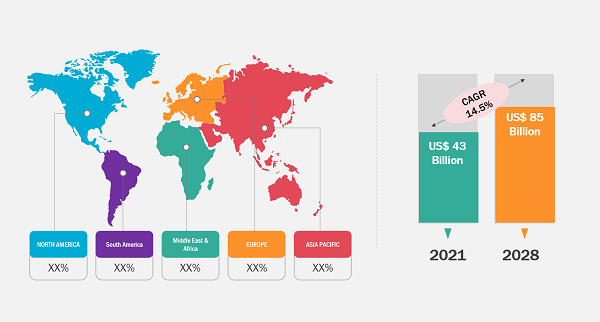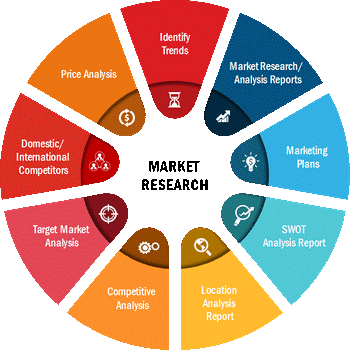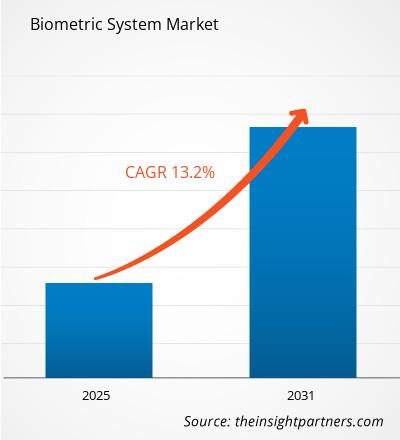生体認証システム市場は、2021 年に 430 億米ドルと評価されています。 2022 年から 2031 年までに 14.5% の年間平均成長率 (CAGR) で成長すると推定されています
生体認証システムは、指紋、虹彩、声、顔、手の形状、掌紋、署名、タイピング パターンなどを分析および測定することにより、個人の認証と識別に使用されます。生体認証システムは、機密データを保護し、ATM、携帯電話、スマート カード、デスクトップ、ラップトップ、およびネットワークへのアクセスの不正使用を回避するために使用されます。このように、商業および産業部門における認証と識別に対する需要の高まりが、生体認証システムの成長を促進しています。
市場のダイナミクス
生体認証システムの成長に寄与する主な要因としては、従来の PIN ベースの方法よりも先進技術の採用が増加していることが挙げられます。そして商業および電子商取引における生体認証ソリューションのアプリケーションの増加。オフィスビルや政府機関の建物では、大量の機密情報を保護するために指紋認証と虹彩認証の導入が急速に進んでいます。生体認証ソリューションはセキュリティを強化し、空港、オフィス施設、ショッピング施設、その他の機密スペースへの権限のない個人の立ち入りを制限するのに役立つため、その市場は予測期間中も引き続き推進されるでしょう。
< span style="font-family: verdana, Geneva, sans-serif; font-size: 10pt;">市場範囲
“グローバル 2031 年までの生体認証システム市場分析"このレポートは、製品、機能、認証タイプ、エンドユーザーに基づいた詳細な市場セグメンテーションとともに、生体認証システムの概要を提供することを目的としています。このレポートは、主要企業の業績に基づいた主要な市場統計を提供します。また、市場の主要なトレンドと機会も提供します。
戦略的洞察
市場セグメンテーション >
世界の生体認証システム市場は、製品、機能、認証タイプ、およびサービスに分類されます。エンドユーザー。生体認証システム市場は、提供内容に基づいてハードウェアとソフトウェアに分類されます。生体認証システム市場は機能別に、接触機能、非接触機能、複合機能に分類されます。生体認証システム市場は、認証の種類別に一要素認証と多要素認証に分類されます。エンドユーザーの基準から見ると、生体認証システム市場は BFSI、政府、軍事および組織に分類されます。防衛、家庭用電化製品、ヘルスケア、自動車など。
世界の生体認証システム市場は 5 つの主要な市場に分類されています地域 北米、ヨーロッパ、アジア太平洋、中東、およびアフリカ、そして南と南。中米。このレポートでは、世界 18 か国の分析と予測、および言及された地域全体に広がっている傾向と機会を取り上げています。
地域的な観点から見ると、APAC は 2022 年から 2031 年の予測期間中に最も速い CAGR で成長すると予測されています。エンドユーザーからの需要は目覚しい速度で増加しており、その結果、生体認証を含む高度なセキュリティ ソリューションへの需要が生まれています。オフィスビル、政府機関の複合施設、BFSIなどの産業部門、医療施設、自動車工場の建設が、地域市場の成長にさらに弾みを加えています。前述のエンド ユーザーの機密データを保護するために、音声認識、指紋スキャン、虹彩認識、顔認識、心拍数センサーは不可欠です。この要因は、生体認証システム市場の成長に大きく貢献すると予想されます。
以下の図は、世界の生体認証システム市場の収益成長傾向を示しています。
 出典: Insight Partners 分析
出典: Insight Partners 分析
レポートは、推進要因、制約、機会、将来の傾向などの要因を分析します。 、生体認証システム市場に影響を与えます。また、生体認証システム市場に影響を与える要因の徹底的な PEST 分析も提供します。
新型コロナウイルス感染症のパンデミックの影響
生体認証システムは、さまざまなスキャナーを使用して、行動パターンまたは生理学的パターンを測定することで個人の身元を確認します。測定を実行するために直接触れる必要がない非接触生体認証システムがいくつかあります。ただし、指紋認証システムでは、システムが特性を適切に読み取り、測定できることを保証するために、スキャナーに直接物理的に接触するユーザーの外見が必要です。物理的な存在を必要とするシステムでは、相互汚染の可能性が高まる可能性があります。この要因は、タッチベースの指紋生体認証デバイスの普及に悪影響を及ぼしました。しかし、生体認証システムの回復段階では、人間の直接の接触を伴わない生体認証システムの採用が増加しています。新型コロナウイルス感染症(COVID-19)ウイルスの感染拡大を抑制するために、虹彩と音声認識の需要が高まりました。
市場参加者
さまざまな企業が、製品の発売、製品の承認、特許、イベントなどの有機的な成長戦略に注力しています。買収、パートナーシップ、コラボレーションなどの無機的な成長戦略が、ビジネスと顧客ベースの拡大を促進してきました。生体認証システム市場で活動する市場関係者は、生体認証システムの需要の高まりにより、今後数年間に大きな成長の機会を経験すると予想されます。
このレポートには、主要な生体認証システム企業のプロフィールと、SWOT 分析および市場戦略も含まれています。さらに、このレポートは、企業概要、提供されるコンポーネントとサービス、過去 3 年間の財務情報、過去 5 年間の主要な開発などの情報を提供する業界の主要企業に焦点を当てています。生体認証システム市場に携わる数社のリストを以下に示します。
- Assa Abloy AB
- FaceFirst
- 富士通株式会社
- IDEMIA (アドベント インターナショナル)
- Iris ID, Inc.
- 日本電気株式会社
- 正確な生体認証
- Secunet Security Networks AG
- SUPREMA
- タレス グループ
Insight Partner の専任の調査分析チームは、高度な統計専門知識を持つ経験豊富な専門家で構成されており、既存の調査にさまざまなカスタマイズ オプションを提供します。
 < /スパン>
< /スパン>
- 過去2年間の分析、基準年、CAGRによる予測(7年間)
- PEST分析とSWOT分析
- 市場規模価値/数量 - 世界、地域、国
- 業界と競争環境
- Excel データセット


- Electronic Signature Software Market
- Dairy Flavors Market
- Water Pipeline Leak Detection System Market
- Oxy-fuel Combustion Technology Market
- Energy Recovery Ventilator Market
- Wind Turbine Composites Market
- Medical Collagen Market
- Biopharmaceutical Tubing Market
- Asset Integrity Management Market
- Redistribution Layer Material Market

Report Coverage
Revenue forecast, Company Analysis, Industry landscape, Growth factors, and Trends

Segment Covered
This text is related
to segments covered.

Regional Scope
North America, Europe, Asia Pacific, Middle East & Africa, South & Central America

Country Scope
This text is related
to country scope.
よくある質問
Some of the customization options available based on the request are an additional 3–5 company profiles and country-specific analysis of 3–5 countries of your choice. Customizations are to be requested/discussed before making final order confirmation, as our team would review the same and check the feasibility.
The leading players operating in the Biometric System Market include HID Global Corporation, Bio Key International, NEC Corporation, Thales Group, Fulcrum Biometric Inc., Nuance Communication Inc., Precise Biometric, Qualcomm Technology, Dreamlog Identification System Inc., Daon Inc.
The global Biometric System Market is expected to grow at a CAGR of 13.2% during the forecast period 2024 - 2031.
Rise of Mobile Biometric Solutions, Integration of Biometric Systems with IoT Devices, Growing Adoption of Multi-Modal Biometric Systems is the key future trend of the Biometric System Market
The major factors driving the Biometric System Market is Growing Need for Enhanced Security Solutions, Technological Advancements in Biometric Technologies, Increasing Government Initiatives and Regulations.
The report can be delivered in PDF/PPT format; we can also share excel dataset based on the request.
Trends and growth analysis reports related to Electronics and Semiconductor : READ MORE..
The List of Companies
1. Assa Abloy AB
2. FaceFirst
3. Fujitsu Limited
4. IDEMIA
5. Iris ID, Inc.
6. NEC Corporation
7. Precise Biometrics
8. Secunet Security Networks AG
9. SUPREMA
10. Thales Group
The Insight Partners performs research in 4 major stages: Data Collection & Secondary Research, Primary Research, Data Analysis and Data Triangulation & Final Review.
- Data Collection and Secondary Research:
As a market research and consulting firm operating from a decade, we have published and advised several client across the globe. First step for any study will start with an assessment of currently available data and insights from existing reports. Further, historical and current market information is collected from Investor Presentations, Annual Reports, SEC Filings, etc., and other information related to company’s performance and market positioning are gathered from Paid Databases (Factiva, Hoovers, and Reuters) and various other publications available in public domain.
Several associations trade associates, technical forums, institutes, societies and organization are accessed to gain technical as well as market related insights through their publications such as research papers, blogs and press releases related to the studies are referred to get cues about the market. Further, white papers, journals, magazines, and other news articles published in last 3 years are scrutinized and analyzed to understand the current market trends.
- Primary Research:
The primarily interview analysis comprise of data obtained from industry participants interview and answers to survey questions gathered by in-house primary team.
For primary research, interviews are conducted with industry experts/CEOs/Marketing Managers/VPs/Subject Matter Experts from both demand and supply side to get a 360-degree view of the market. The primary team conducts several interviews based on the complexity of the markets to understand the various market trends and dynamics which makes research more credible and precise.
A typical research interview fulfils the following functions:
- Provides first-hand information on the market size, market trends, growth trends, competitive landscape, and outlook
- Validates and strengthens in-house secondary research findings
- Develops the analysis team’s expertise and market understanding
Primary research involves email interactions and telephone interviews for each market, category, segment, and sub-segment across geographies. The participants who typically take part in such a process include, but are not limited to:
- Industry participants: VPs, business development managers, market intelligence managers and national sales managers
- Outside experts: Valuation experts, research analysts and key opinion leaders specializing in the electronics and semiconductor industry.
Below is the breakup of our primary respondents by company, designation, and region:

Once we receive the confirmation from primary research sources or primary respondents, we finalize the base year market estimation and forecast the data as per the macroeconomic and microeconomic factors assessed during data collection.
- Data Analysis:
Once data is validated through both secondary as well as primary respondents, we finalize the market estimations by hypothesis formulation and factor analysis at regional and country level.
- Macro-Economic Factor Analysis:
We analyse macroeconomic indicators such the gross domestic product (GDP), increase in the demand for goods and services across industries, technological advancement, regional economic growth, governmental policies, the influence of COVID-19, PEST analysis, and other aspects. This analysis aids in setting benchmarks for various nations/regions and approximating market splits. Additionally, the general trend of the aforementioned components aid in determining the market's development possibilities.
- Country Level Data:
Various factors that are especially aligned to the country are taken into account to determine the market size for a certain area and country, including the presence of vendors, such as headquarters and offices, the country's GDP, demand patterns, and industry growth. To comprehend the market dynamics for the nation, a number of growth variables, inhibitors, application areas, and current market trends are researched. The aforementioned elements aid in determining the country's overall market's growth potential.
- Company Profile:
The “Table of Contents” is formulated by listing and analyzing more than 25 - 30 companies operating in the market ecosystem across geographies. However, we profile only 10 companies as a standard practice in our syndicate reports. These 10 companies comprise leading, emerging, and regional players. Nonetheless, our analysis is not restricted to the 10 listed companies, we also analyze other companies present in the market to develop a holistic view and understand the prevailing trends. The “Company Profiles” section in the report covers key facts, business description, products & services, financial information, SWOT analysis, and key developments. The financial information presented is extracted from the annual reports and official documents of the publicly listed companies. Upon collecting the information for the sections of respective companies, we verify them via various primary sources and then compile the data in respective company profiles. The company level information helps us in deriving the base number as well as in forecasting the market size.
- Developing Base Number:
Aggregation of sales statistics (2020-2022) and macro-economic factor, and other secondary and primary research insights are utilized to arrive at base number and related market shares for 2022. The data gaps are identified in this step and relevant market data is analyzed, collected from paid primary interviews or databases. On finalizing the base year market size, forecasts are developed on the basis of macro-economic, industry and market growth factors and company level analysis.
- Data Triangulation and Final Review:
The market findings and base year market size calculations are validated from supply as well as demand side. Demand side validations are based on macro-economic factor analysis and benchmarks for respective regions and countries. In case of supply side validations, revenues of major companies are estimated (in case not available) based on industry benchmark, approximate number of employees, product portfolio, and primary interviews revenues are gathered. Further revenue from target product/service segment is assessed to avoid overshooting of market statistics. In case of heavy deviations between supply and demand side values, all thes steps are repeated to achieve synchronization.
We follow an iterative model, wherein we share our research findings with Subject Matter Experts (SME’s) and Key Opinion Leaders (KOLs) until consensus view of the market is not formulated – this model negates any drastic deviation in the opinions of experts. Only validated and universally acceptable research findings are quoted in our reports.
We have important check points that we use to validate our research findings – which we call – data triangulation, where we validate the information, we generate from secondary sources with primary interviews and then we re-validate with our internal data bases and Subject matter experts. This comprehensive model enables us to deliver high quality, reliable data in shortest possible time.

 このレポートの無料サンプルを入手する
このレポートの無料サンプルを入手する